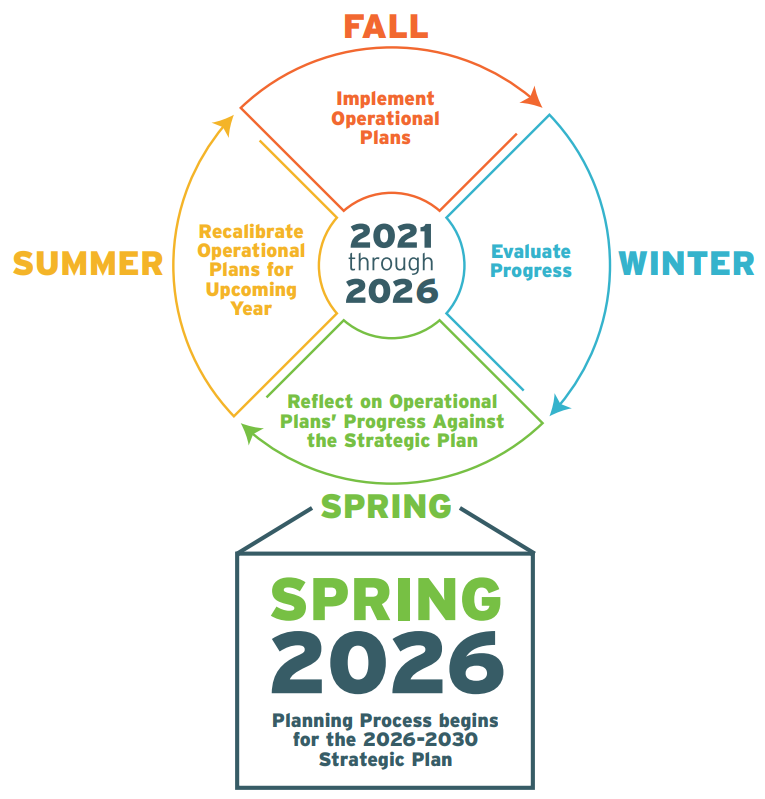Office of the President Measuring Impact & Assessing Success Strategic Plan TargetsKey Performance Indicators (KPI) Dashboards
Trust, Clarity, and Success
The Five-Year Strategic Plan is for everyone in our Queensborough community. It is designed to communicate honestly, clearly, and respectfully. Our goal is to develop a shared understanding of where we are and where we want to go. With deep insight and courage, great outcomes become possible. Together, we will learn and grow from this process — and succeed!
Success at Queensborough
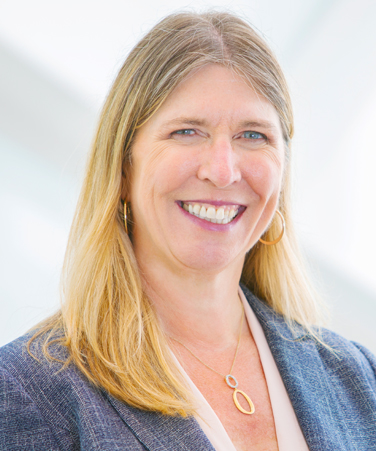
The Queensborough Community College Five-Year Strategic Plan is the outcome of a collaborative, inclusive, from the ground-up process among students, faculty, staff, alumni, business partners, and many other valued members of our community. It is based on our Mission; our commitment to develop students holistically in a nurturing and diverse environment that prepares them to be successful in a dynamic, global workforce.
In the summer of 2020, against a national backdrop of protests about longstanding systemic and institutionalized racism, Queensborough reexamined its Mission, especially in relation to education outcomes and economic opportunities for our Black, Brown, and other communities of color.
We decided to recommit and revive our Mission of student success by deepening our understanding of our students, their experiences, and identities to create true transformation within our College.
In the months that followed, we entered a profound inquiry of race, cultural differences, and equity, thinking critically and creatively, and asking ourselves how we could make Queensborough an even better place for every person who wants to belong, work, study, and grow with us.
The result is this, our first five-year Plan, which we will use to listen more critically and respond more effectively to the varying needs and expectations of our students, faculty, staff, and community.
This is a planning document, not a perfect document. Think of it, and the Operational Plans produced because of it, as workbooks to constantly refer to, mark up, and write on with your observations, critiques, and ideas.
Be prepared to share your insights, because as we monitor our progress over the course of the Strategic Plan, we will listen (and act on!) what you have to say about it. Together, we will make any adjustments required to build a more inclusive, equitable Queensborough and accelerate our success.
Thank you, everyone, for your hard work.
Chris
Dr. Christine Mangino
President, Queensborough Community College
Equity Makes Success Possible for Everyone
Equity and equality are not interchangeable. Understanding the distinction between the two is essential for redefining Queensborough’s education experience and making success possible for everyone.
The illustrations in the next sections, based on resources from the Center for Urban Education, show the difference. One way of defining equality is that everyone gets treated by our structures, systems, and policies the same exact way, regardless of individual need, life experience, or circumstance. Equity, however, means undoing what we have done and implementing active, responsive structures, systems, and policies that ensure every individual is provided with the environment, resources, opportunities, and means he/she/they need to succeed.
In education, equity and equality are both aspirational goals. Systemic inequities from pre-k through to college have led to unequal systems throughout the nation that continue to produce unequal outcomes, which disproportionately affect our Black, Latinx, and Native American communities. Joining educators across the nation, Queensborough is confronting and addressing policies, processes, and structures that contribute to these unjust and unequal outcomes.
Analyses of our data demonstrate that there are inequities throughout our students’ Queensborough experience. From entry through to academic milestones and in our graduation rates, Queensborough is not producing the same results for all students. The responsibility for this is ours.
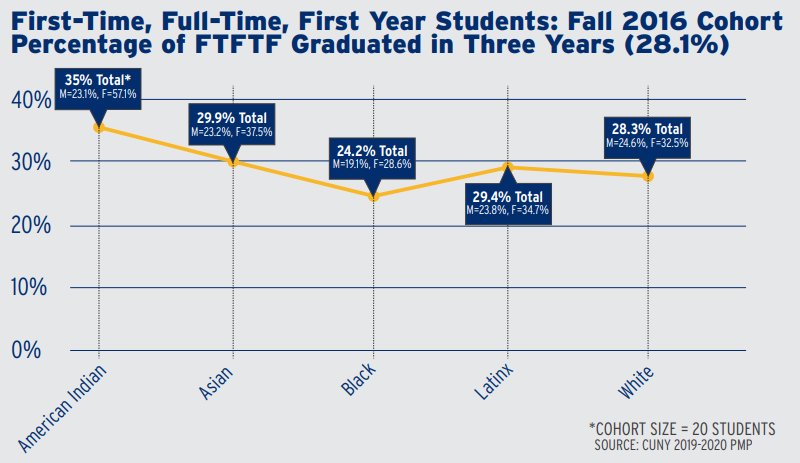
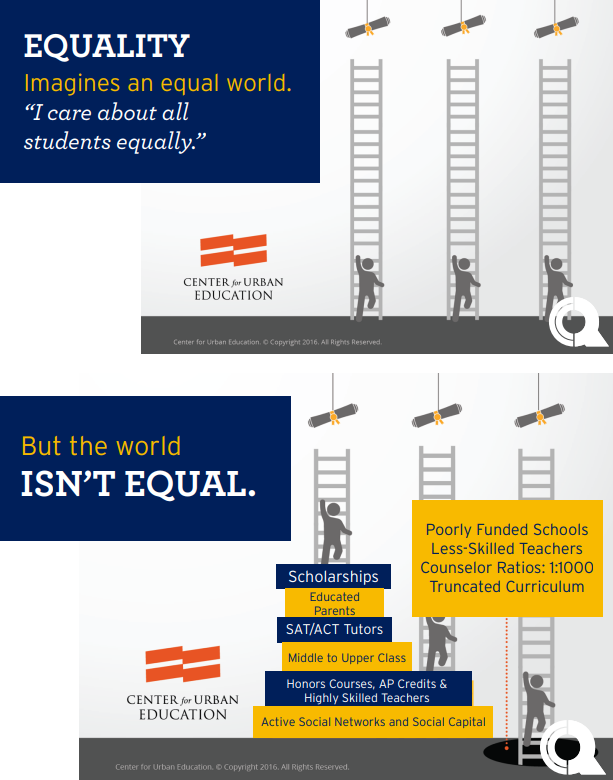

No two Queensborough students are the same
Too often, we blame a student’s social, cultural, or educational background for his/her/ their inequitable outcomes. In return, we act to “fix” the student, with more tutoring, mentors, and workshops, all of which are beneficial. However, if we attempt to address the student only and not the system, we will never get anywhere. We must be intentional, therefore, and fix our structures, policies, and practices to transform Queensborough into an institution that will deliver the same outcomes for all our students.
We will achieve this by positioning equity at the forefront of everything we do, as specified in this 5-Year Strategic Plan. Even though the disparities in educational experiences and opportunities occur long before our students enroll here, they can (and will!) end the moment they engage with us.
With focused plans, concerted efforts, and deep reflection about who we are and how we serve our community, Queensborough will not just respond to the urgent call of this moment. We will rise to ensure every student’s success and provide each student with an unrivaled education.
Equity at the Forefront
Equity is at the forefront of our thinking and planning at Queensborough. We will create meaningful, systemic change to produce structures that deliver equal outcomes across all racial and gender groups.
Guiding Questions about Equity
Diversity, Equity, Inclusion and Belonging (DEIB) can feel like nebulous and aspirational goals, but they are not. DEIB goals are operationalized through focused examination of our work and intentional decisions to change how we work. The questions below should guide planning at the institution for the life of the Strategic Plan.
- Diversity: How has data disaggregated by race and gender been collected, analyzed, and used to inform planning?
- Equity: Which of the Strategic Plan’s equity targets will be positively impacted?
- Inclusion: Is there a range of identities, backgrounds, and experiences present that is reflective of the student body?
- Belonging: Are social, cultural, racial and/or education backgrounds being blamed for inequitable outcomes or experiences? How is institutional responsibility being considered?
Planning for the Plan
We’re In This Together
Few occasions outside of our College commencement bring hundreds of students, faculty, staff, and external stakeholders together for a single cause. The Five-Year Strategic Plan did. Not all at one time or in one place of course, but over the last year, we have drawn together people from across Queensborough with vastly different experiences, cultures, knowledge, perspectives, and values to share their feelings about, and contribute their ideas to, the future of Queensborough. We hosted Town Halls, held Zoom meetings, distributed surveys, conducted research, and talked extensively with stakeholders to ensure that the planning process was engaging, inclusive, evidence-informed, and transparent.
Led by Queensborough’s Dean for Institutional Effectiveness, Dr. Arthur Corradetti, and propelled by a cross-section of people who deeply care for Queensborough, we synthesized an array of information from within and outside of the College. We benefitted from interactions with more than 500 individuals, who informed our plans and heightened our ambitions for the future.
The results of the process are:
- An honest, shared understanding of our College;
- An iterative, incremental, and inclusive planning process; and
- The Plan, which sets out expectations and aspirations, (to be reviewed and revisited) for the next five years
"There have been, and continue to be, important conversations about how we fit into the lives of our students. Please keep the conversation going and share your ideas. We look forward to hearing from you and working together to further advance our students, strengthen our College, and grow our community."
— Dr. Arthur Corradetti
Dean for Institutional Effectiveness
Five-Year Strategic Plan Process

Vision
Our Vision defines us, motivates us, engages us, and connects us: Every significant action at Queensborough contributes to fully attainable, life-changing higher education for one of the most diverse urban communities in the world.
Mission
Queensborough Community College is dedicated to academic excellence and rigor and to providing an affordable, high-quality education to pre-college, college, and lifelong learners. Our faculty and staff are committed to the holistic development of today’s students in a nurturing and diverse environment that prepares them to be successful in a dynamic workforce. The College affirms its open admissions policy and its strong support of critical thinking, intellectual inquiry, global awareness, civic responsibility, and cultural and artistic appreciation.
- Approved by the Academic Senate on May 10, 2016; revised on February 14, 2017
Values
At Queensborough, we engender, cultivate, and uphold respect, inclusivity, compassion, and responsibility. We focus on student success, learn from each other, and defy expectations!
Planning Process Outcomes
Through information gathering, consultation, and review, concepts emerged in the Planning Process among students, colleagues, and other members of our community, which reinforced the College’s statement of values.
From the outset, we determined that Equity would be at the forefront of our thinking and planning and that Queensborough would create meaningful, systemic change to produce structures and systems that deliver equal outcomes across racial and gender groups.
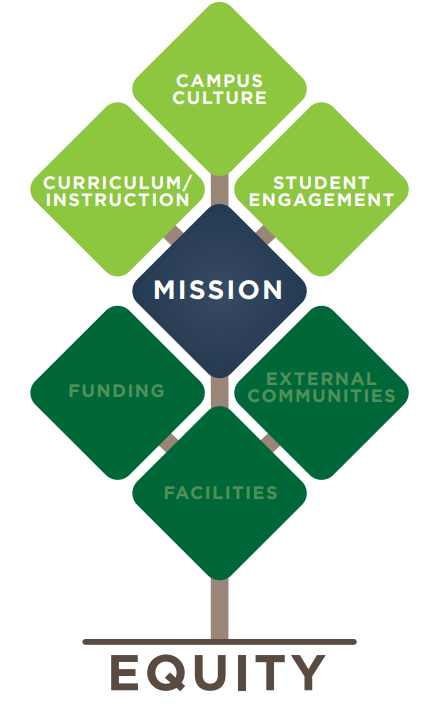
We prioritized our Campus Culture, wanting to Cultivate a Community of Care that would support and sustain us as well as our teaching and learning environments.
We wanted to emphasize Student Engagement, acknowledging that Queensborough needed to become student-ready to support and meet students where they were.
We also concluded that further development of our Curriculum and Instruction would be essential to our students’ career-readiness and success. By reimagining the Queensborough Academies we plan to leverage best practice in teaching and learning; improve students’ career readiness; and promote coherence, collaboration, and connection throughout the College.
CAMPUS CULTURE | Cultivating a Community of Care
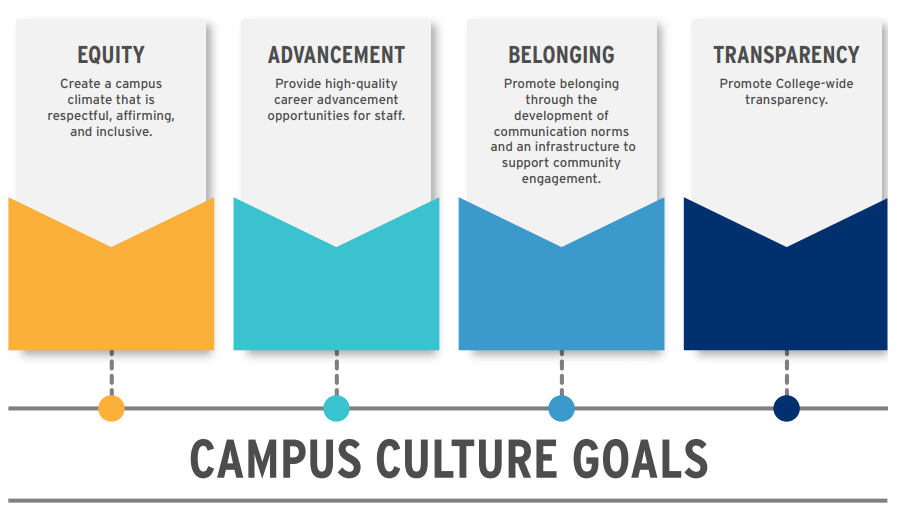
Community defines Queensborough Community College. But what defines community? When we speak of community, Queensborough identifies key characteristics— Equity, Advancement, Belonging, and Transparency—which describe our capacity as an institution to be inclusive and work with dignity, humanity, and justice for the benefit of the individual student, faculty, or staff and the College. This mutual caring, or Cultivating of a Community of Care, shapes all aspects of our interactions and forms the basis of all our support for Queensborough students, faculty, and staff.

STUDENT ENGAGEMENT | Reimagining the Queensborough Academies


Everything we do, all facets of our Five-Year Strategic Plan, must be student-centered and address critical elements of the student experience. We are committed to student success, making deliberate efforts to transform the College by enabling equitable outcomes. We will advance student success by reimagining our Queensborough Academies: providing higher impact learning, delivering more coherent and collaborative support services, and enabling stronger connections among faculty, staff, students, and the community that lead to greater undergraduate success.
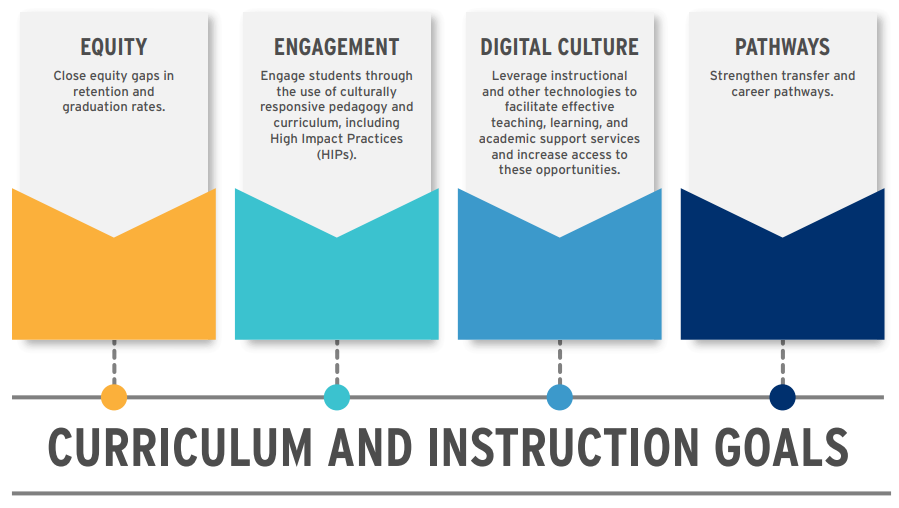

How do we connect students’ interests and passions to careers, prepare them for advanced degrees, and give them clarity as to what happens after graduation? By focusing on equitable outcomes, culturally responsive academic content (engagement), embracing emerging technologies (digital culture), and nurturing emotional development, we will ensure that students will graduate Queensborough as lifelong learners with the knowledge and skills they need to reach their goals. Through focused attention on strengthening Queensborough’s transfer and career pathways, we support our students’ social mobility and educational dreams.
Measuring Impact & Assessing Success
Operational Planning Overview: Making opportunity equal and real for everyone.
Campus Culture | Cultivating a Community of Care
Cultivating a Community of Care shapes all aspects of our interactions and forms the basis of all our support for Queensborough students, faculty, and staff. We will focus on engagement and success by creating a campus that is respectful, affirming, and inclusive.
Five-Year Target
Faculty and staff climate-survey results will demonstrate an increase in overall satisfaction and sense of belonging, respect, affirmation, inclusivity, and transparency.
Key Performance Indicators
- Increased retention of faculty and staff
- Increased belonging among faculty
- Increased belonging among staff
- Decreased gaps in underutilization for all titles
- Increased satisfaction with professional development
Goals |
Desired Outcomes |
|---|---|
|
Create a campus climate that is respectful, affirming, and inclusive |
Campus community that feels respected, whose work is valued, and that is inclusive Recruit and retain a more diverse workforce |
|
Promote belonging through the development of communication norms and an infrastructure to support community engagement |
Increase sense of belonging of the campus community |
|
Provide high-quality career advancement opportunities for staff |
Enhance the opportunities for ongoing professional development |
|
Promote College-wide transparency |
Campus community easily accesses documentation of processes and policies |
Student Engagement | Reimagining the Queensborough Academies
We will reimagine our Queensborough Academies by being student-centered and addressing critical elements of their experience. We will provide higher impact learning, deliver more comprehensive support, and eliminate obstacles to student success.
Five-year Target
First-time, full-time student fall-to-fall retention rate will increase from 61.5% (fall 2019 cohort) to 75% (fall 2025 cohort).
Disproportionately Impacted Population Target
- Black male baseline is 48.7% (fall 2019 cohort)
- Latinx male baseline is 53.5% (fall 2019 cohort)
Key Performance Indicators
- Increased fall-to-spring retention rates
- Decreased number of students who earn a zero GPA in their first semester
- Decreased number of students who graduate with credits in excess of
curriculum requirement - Increased number of students with a GPA above 2.0 (all associate- and
certificate-seeking students) - Increased number of students who earn 20 credits in the first year
- Increased number of students who earn 30 credits in the first year
- Increased Gateway English course completion in the first year
- Increased Gateway Math course completion in the first year
- Decreased change of majors after 24 credits
Goals |
Desired Outcomes |
|---|---|
|
Create belonging and community through welcoming and inclusive practices |
Increase sense of belonging and community across all sectors |
|
Provide students with a seamless pathway to graduation |
Students will have clear achievable indicators throughout their academic journey at Queensborough |
|
Increase effectiveness of campus-wide student support through collaboration |
Students feel supported and well informed about degree requirements Advisers, academic departments, and support areas share information and meet regularly |
|
Provide a meaningful and comprehensive model that provides students with a first-year experience and beyond that links curricula and co-curricular programming with career and/or transfer goals |
New students feel well supported and in the know of our resources to be successful Students achieve milestones along their chosen pathway, ensuring completion of degree |
Curriculum & Instruction | Become a Student-Ready College
We will focus on culturally responsive academic content, connect students’ interests and passions to careers, prepare them for advanced degrees, and give them clarity as to what happens after graduation.
Five-year Target
Three-year graduation rate will increase from 29.2% (fall 2017 cohort) to 40% (fall 2025 cohort)
Disproportionately Impacted Population Target
- Black male baseline is 16.3% (fall 2017 cohort)
- Latinx male baseline is 24.1% (fall 2017 cohort)
Key Performance Indicators
- Increased number of students with paid internships
- Increased number of online and hybrid courses that meet national standards for quality
- Increased fall-to-fall retention
- Increased three-year graduation
- Increased student mattering
- Increased number of student transfers for AA/AS
- Increased number of students with consistent employment one year after AAS graduation
Goals |
Desired Outcomes |
|---|---|
|
Close equity gaps in retention and graduation rates |
Graduation and retention rates are not significantly different across gender and racial groups |
|
Leverage instructional and other technologies to facilitate effective teaching, learning, and academic support services and to increase access to these opportunities |
Increase the number of online and hybrid courses that meet a national standard for quality |
|
Engage students through the use of culturally responsive pedagogy and curriculum, including High Impact Practices (HIPs) |
CETL provides faculty development opportunities that support the College’s academic initiatives (e.g., evidence-based, effective teaching practices and scholarship that engages CRP) and respond to faculty and student needs |
|
Strengthen transfer and career pathways |
Students achieve milestones along their chosen pathway, ensuring completion of degree Increase numbers of students participating in internships, apprenticeships, or other experiential learning |
About the Planning Process
We, the College community, will determine the outcome of the Strategic Plan through an annual cycle of planning, implementing, evaluating, adjusting, and planning again. Operational Plans across the College will support the Five-Year Strategic Plan.
- FALL/ Implement Operational Plans
- WINTER/ Evaluate Progress
- SPRING/ Reflect on Operational Plans’ Progress Against the Strategic Plan
- SUMMER/ Recalibrate Operation Plans for Upcoming Year



